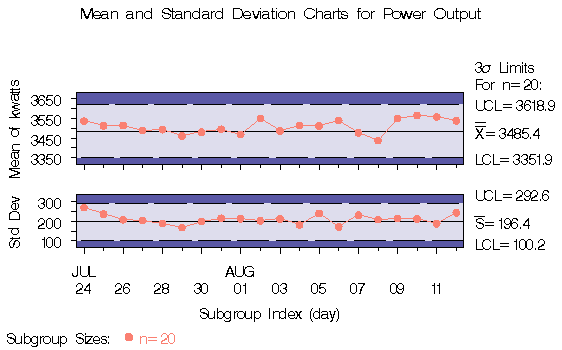Chapter Contents
Previous
Next
|
Chapter Contents |
Previous |
Next |
| XSCHART Statement |
| See SHWXS1 in the SAS/QC Sample Library |
In the previous example,
the OUTLIMITS= data set TURBLIM
saved control limits computed from the measurements in TURBINE.
This example shows how these limits can be applied
to new data.
The following statements create ![]() and s charts for
new measurements in a data set named TURBINE2 (not listed here)
using the control limits in TURBLIM:
and s charts for
new measurements in a data set named TURBINE2 (not listed here)
using the control limits in TURBLIM:
title 'Mean and Standard Deviation Charts for Power Output';
symbol v=dot c=salmon;
proc shewhart data=turbine2 limits=turblim;
xschart kwatts*day / cframe = lib
cinfill = bwh
coutfill = yellow
cconnect = salmon;
run;
The charts are shown in Figure 44.8.
The LIMITS= option in the PROC SHEWHART statement specifies the
data set containing preestablished control limit information.
By default,*
this information is read from the first
observation in the LIMITS=
data set for which

|
The means and standard deviations lie within the control limits, indicating that the heating process is still in statistical control.
In this example, the LIMITS= data set was created in a previous run of the SHEWHART procedure. You can also create a LIMITS= data set with the DATA step. See "LIMITS= Data Set" for details concerning the variables that you must provide.
|
Chapter Contents |
Previous |
Next |
Top |
Copyright © 1999 by SAS Institute Inc., Cary, NC, USA. All rights reserved.